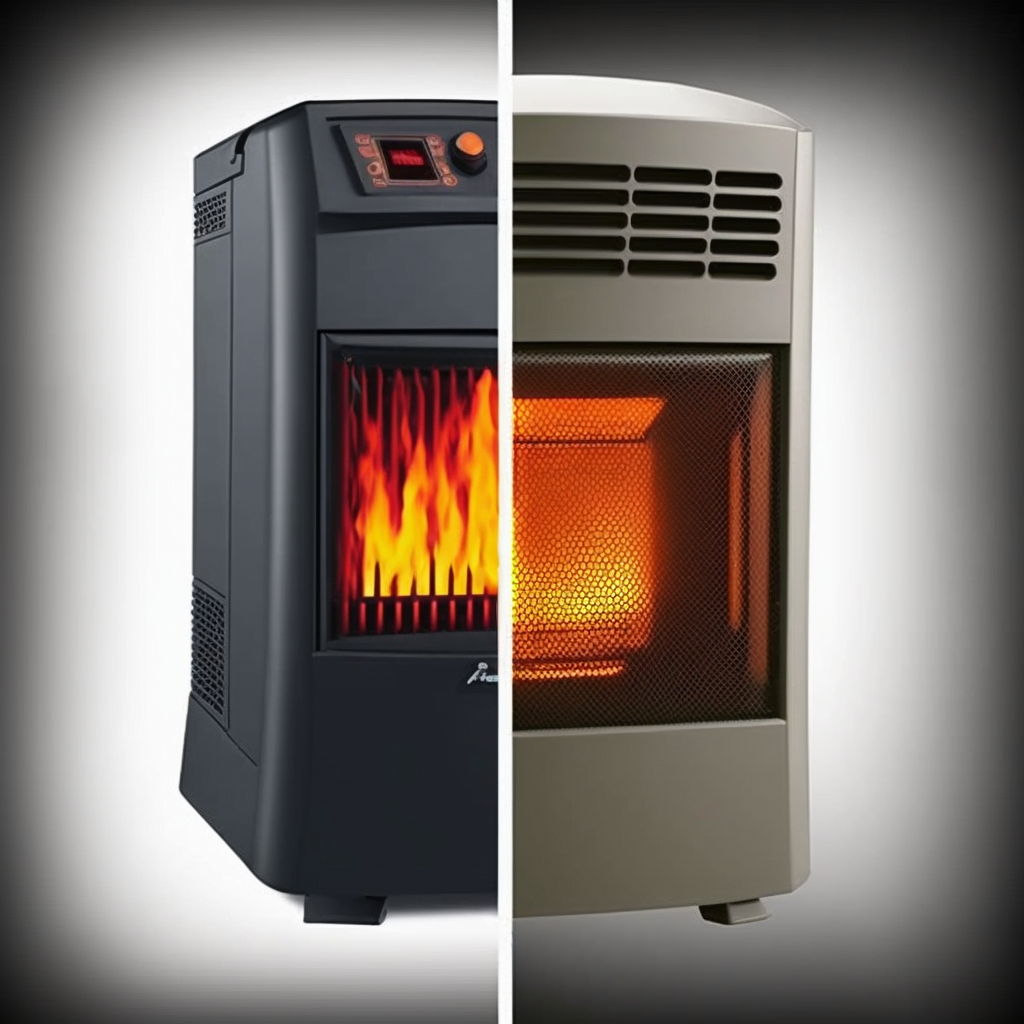Whatever you do, do not buy an electric heater. While there are some situations where an electric heater might be the best heating option, I think most people do not understand why electric heaters are bad and a waste of money. This is done deliberately because manufacturers charge a premium for electric heaters which are cheap to manufacturer. Advertising material talks about how efficient and cost effective electric heaters are but if people really understood what it all meant they wouldn’t waste their money on them. This website is dedicated to pellet heaters, so I’ll naturally say why I think they are better than electric heaters, but read on to learn why you shouldn’t buy an electric heater.

To save you time, I’ve created an FAQ or short version of the blog post. Read this to quickly see why I don’t think or at the very least have realistic expectations at how well any kind of electric heater is going to heat your room or house:
Why shouldn’t I buy an electric heater?
Electric heaters are often advertised as efficient and cost-effective, but they can actually be quite expensive to run due to how much electricity costs. You’ll see a massive jump in your power bill if you use an electric heater a lot.
Are pellet heaters more cost-effective than electric heaters?
Yes, pellet heaters are generally much cheaper to run compared to electric heaters. In regions like Tasmania, the running cost per kilowatt for a pellet heater is roughly half of that for an electric heater and are much better at heating large areas.
Are electric heaters suitable for large rooms?
Electric heaters are better suited to small to medium-sized rooms. For larger rooms, they are very expensive to run because they are not designed to heat large spaces, so will constantly be on using electricity and costing you money. Pellet heaters, on the other hand, can effectively heat rooms of any size and do so more efficiently and cost-effectively.
How do electric and pellet heaters differ in heat distribution?
Electric heaters can be inefficient in distributing heat evenly throughout a room, because they aren’t designed to heat large spaces and heat becomes trapped. Pellet heaters, however, use a room fan to distribute hot air evenly and efficiently, resulting in faster room heating and fewer cold spots.
What about the design of electric and pellet heaters?
Most electric heaters have a basic design and tend to blend into the surroundings. However, pellet heaters, especially European brands, come in a variety of colours, shapes, and styles, offering both functionality and aesthetic appeal.
Why should I consider a pellet heater instead of an electric heater one?
If you’re looking to heat more than a small room, a pellet heater is generally a better option. They are more affordable to run, efficient at heating larger spaces, and provide more heat than electric heaters. They also tend to be more visually appealing.
How Pellet Heaters Work
Pellet heaters are a convenient and eco-friendly way to heat a home that burn wood pellets, so you get a lovely natural heat similar to a wood heater. They use a hopper that holds pellets while the pellet hater is running, making them easier to maintain than wood heaters. Wood pellets come in easy to handle bags, don’t need to split or dried like firewood and can be burnt the day you buy them. They are fully automatic, so there’s no need to the light fire, and can heat your room to a set temperature. Pellet heaters are convection heaters, meaning there’s a fan that blows hot air into the room, so they heat areas quickly.
Electric Heaters vs Pellet Heaters Cost to Run
If you buy an electric heater and use it a lot, you will notice a dramatic increase in your power bill. Electricity is not cheap and electric heaters chew through the stuff and cost a fortune to run if used a lot. Most electric heaters pull anywhere from 1kw to 2kw an hour. What’s that going to cost you to run? If you use it for 8 hours a day and you pay 26 cents for kw, then you’ll pay about $2 to $4 a day if that heater was running non-stop. The reality is it won’t as once your room reaches the desired temperature it will switch off. If on for 8 hours it’ll probably only use electricity for 4 hours, so you’ll pay anywhere from $1 to $2 a day.
That means your power bill will go up by $30 to $60 a month. Now, that’s just one heater in one room. If you have one heater in each room in a 3 bedroom house, then you could spend anywhere from $90 to $180 a month in power just to run the heaters. This is why people get bill shock after using a new electric heater for the first time. Then you see these heaters being sold on Facebook or Gumtree and usually have “only used a few times” in the description because once they realized how much they cost to run they get rid of them. It’s worth repeating again. Electric heaters are NOT cheap to run.
Pellet heaters, however, are much cheaper. I wrote an entire post on pellet heater running costs, but basically in Tasmania it’s about 11 cents per kw. Compare that to electricity being about 26 cents per kw. So we are talking a 50% difference in heating costs between a pellet heater and electric heater. The $90 a month in power for an electric heater is now about $45 for a pellet heater. Pellet heaters are much cheaper to run and use as a main source of heat. Electric heaters should be used sparingly and only for short lengths of time. They are just too expensive to run all the time, unlike pellet heaters which are much more affordable.
Electric Heaters vs Pellet Heaters in Large Rooms
Electric heaters are space heaters, just like a pellet heater and wood heater, but they are space heaters for small to medium sized rooms at best. Many people don’t fully understand room size when it comes to heating. An electric heater may be able to heat up to 40m2 and that sounds big, but it’s only just over 6m by 6m in size. That’s a large master bedroom but people try and use electric heaters in lounge rooms, which can easily be 50m2 and bigger. Even running an electric heater in a medium sized room, the heater will be on more than it would be in a small room. As I touched on above, this means it’s going to cost you even more to run.
To run an electric heater cheaply you need to use it in a small room. That would be 25m2 or less. This way the room should heat up quickly, providing it is insulated well, and then switch of. This is the only time I think you should buy and use an electric heater. In a smallish room and only used a couple of hours a day for a month or two per year at most. Sadly, people don’t know this, buy an electric heater to heat their massive lounge room then wonder why it isn’t doing a good job at heating and why their power bill has gone through the room.
Pellet heaters come in a range of sizes from small to very large. Electric heaters, plugin ones, will max out at 2.4kw because that’s the maximum amount of power you can draw through a plug in electric device. Pellet heaters go up to 13kw. That’s five times more heat output and that’s why pellet heaters are great at heating almost any sized room or area. When heating up a room a pellet heater will run in high heat mode, say 13kw, then when the room reaches your desired temperature like 22 degrees, it then goes switches into low heat which is usually around 2 to 3 kw to keep the room warm. If you’ve got a large area to heat, pellet heaters will be much better and do it faster and cheaper than an electric heater can.
Electric Heaters vs Pellet Heaters Heat Distribution
Electric heaters can be inefficient in distributing heat evenly throughout a room. Many electric heaters, like oil heaters or bar heaters, heat cold air into warm and this air circulates slowly around the room. This can make it difficult to maintain a comfortable temperature throughout the room and can also lead to overuse of the heater, which will increase your power bill further. You do get some electric heaters with fans that blow hot air around, but the majority of electric heaters are convection heaters which heat cold air into warm air which then circulates slowly around the room. Some people try and get around this by using multiple heaters, but then you are paying even more money to keep warm.
Pellet heaters are convection heaters also but they have a room fan which blows hot air out into the room. They work much like a heat pump which warms the room blow blowing hot air around. The benefit of this is the room will heat up much quicker and there will be fewer cold spots like you get with an electric heater. This is great in large rooms or even a whole house because the hot air will be forced around the room or house much faster than it would with an electric heater.
Electric Heaters vs Pellet Heaters Design
OK, I left this until last because let’s be honest, to many people it’s not important. However, if you appreciate the finer things in life then you may be looking for a heater with a bit of style. Generally speaking, most electric heaters are very “sterile” in appearance. They are white, grey or black and kind of blend in and look like a small piece of furniture. Pellet heaters, however, especially European brands like Piazzetta pellet heaters or Palazzetti pellet heaters, come in a range of colours, like orange, and many different shapes and styles. They do cost a lot more but are beautiful to look at and extremely high quality.
Summary of Why You Shouldn’t Buy an Electric Heater
If you don’t like pellet heaters, that’s fine. But please do not buy an electric heater if you are looking to heat anything but a small room. Electric heaters are cheap to buy but extremely expensive to run. Pellet heaters are much cheaper to run, better at heating large rooms and warming your house because they put out more heat and are much cheaper to run because you can buy wood pellets for a lot less than what you’ll pay for electricity, at least 50% less. If you are looking to try and heat large area then considering buying a pellet heater or anything but an electric heater.
